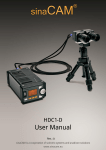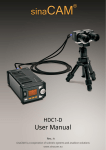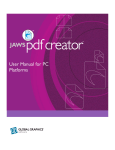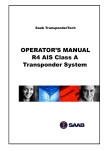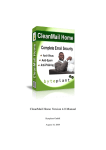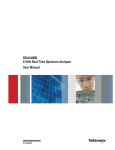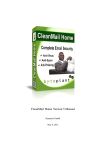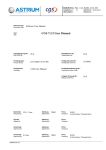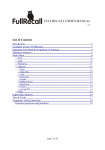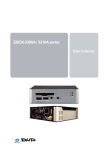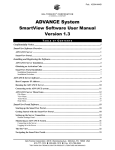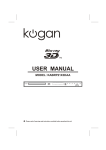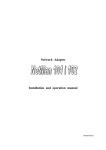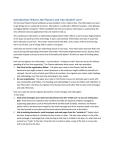Download Arctor User Manual
Transcript
Arctor Version 3.0 Manual Byteplant GmbH January 26, 2009 Contents 1 Introduction 5 1.1 Why You Need A File Backup . . . . . . . . . . . . . . . . . . . 5 1.2 Backup Media . . . . . . . . . . . . . . . . . . . . . . . . . . . . 5 1.3 File-based Backup vs. Image Backup . . . . . . . . . . . . . . . 6 1.4 Why you should use Arctor . . . . . . . . . . . . . . . . . . . . . 7 1.5 Recommended Arctor configurations . . . . . . . . . . . . . . . . 8 1.5.1 Single PC installations . . . . . . . . . . . . . . . . . . . 8 1.5.2 Networked installations . . . . . . . . . . . . . . . . . . 9 Overview . . . . . . . . . . . . . . . . . . . . . . . . . . . . . . 9 1.6 2 Installation 10 2.1 System Requirements . . . . . . . . . . . . . . . . . . . . . . . . 10 2.2 Arctor Setup . . . . . . . . . . . . . . . . . . . . . . . . . . . . . 10 2.3 Uninstalling Arctor . . . . . . . . . . . . . . . . . . . . . . . . . 12 2.3.1 Using Arctor Uninstall . . . . . . . . . . . . . . . . . . . 12 2.3.2 Using The Microsoft Windows Control Panel . . . . . . . 12 Updating Arctor . . . . . . . . . . . . . . . . . . . . . . . . . . . 13 2.4 3 Getting Started 14 3.1 Concepts . . . . . . . . . . . . . . . . . . . . . . . . . . . . . . 14 3.1.1 Rules . . . . . . . . . . . . . . . . . . . . . . . . . . . . 14 3.1.2 Modes . . . . . . . . . . . . . . . . . . . . . . . . . . . . 14 Arctor Main Window . . . . . . . . . . . . . . . . . . . . . . . . 15 3.2.1 Entering Rules . . . . . . . . . . . . . . . . . . . . . . . 16 3.2.2 Viewing Selected Files . . . . . . . . . . . . . . . . . . . 17 3.2 1 4 3.2.3 Viewing Selected File Sizes . . . . . . . . . . . . . . . . 18 3.2.4 Executing Rules . . . . . . . . . . . . . . . . . . . . . . 18 3.2.5 Editing Rule Groups . . . . . . . . . . . . . . . . . . . . 19 3.3 Restore Wizard . . . . . . . . . . . . . . . . . . . . . . . . . . . 20 3.4 Preferences Wizard . . . . . . . . . . . . . . . . . . . . . . . . . 21 Using Arctor 22 4.1 How Arctor Works . . . . . . . . . . . . . . . . . . . . . . . . . 22 4.1.1 Rule Execution . . . . . . . . . . . . . . . . . . . . . . . 22 4.1.2 Archive files . . . . . . . . . . . . . . . . . . . . . . . . 23 4.2 Toolbar and Menu Commands . . . . . . . . . . . . . . . . . . . 23 4.3 Statistics and Information . . . . . . . . . . . . . . . . . . . . . . 25 4.3.1 Files . . . . . . . . . . . . . . . . . . . . . . . . . . . . . 25 4.3.2 Sizes . . . . . . . . . . . . . . . . . . . . . . . . . . . . 26 4.3.3 S.M.A.R.T. . . . . . . . . . . . . . . . . . . . . . . . . . 27 4.3.4 Disk Usage . . . . . . . . . . . . . . . . . . . . . . . . . 28 4.3.5 I/O . . . . . . . . . . . . . . . . . . . . . . . . . . . . . 28 4.3.6 Summary . . . . . . . . . . . . . . . . . . . . . . . . . . 29 Restoring Files . . . . . . . . . . . . . . . . . . . . . . . . . . . 29 4.4.1 Restore Wizard . . . . . . . . . . . . . . . . . . . . . . . 29 4.4.2 Restoring Files Manually . . . . . . . . . . . . . . . . . . 31 Using the Arctor Service . . . . . . . . . . . . . . . . . . . . . . 31 4.5.1 Installation . . . . . . . . . . . . . . . . . . . . . . . . . 31 4.5.2 Using Arctor When The Service Is Installed . . . . . . . . 32 4.4 4.5 5 Configuration 33 5.1 Rule Settings . . . . . . . . . . . . . . . . . . . . . . . . . . . . 33 5.1.1 Rule Name . . . . . . . . . . . . . . . . . . . . . . . . . 34 5.1.2 Rule Enabled . . . . . . . . . . . . . . . . . . . . . . . . 34 5.1.3 Source Directory . . . . . . . . . . . . . . . . . . . . . . 34 5.1.4 Recurse Subdirectories . . . . . . . . . . . . . . . . . . . 35 5.1.5 Include/Exclude Filter Patterns . . . . . . . . . . . . . . . 35 5.1.6 Archive Directory . . . . . . . . . . . . . . . . . . . . . 35 5.1.7 Smart Backup . . . . . . . . . . . . . . . . . . . . . . . . 36 2 5.2 5.3 6 Compress Files . . . . . . . . . . . . . . . . . . . . . . . 37 5.1.9 Versions To Keep . . . . . . . . . . . . . . . . . . . . . . 37 5.1.10 Days To Keep . . . . . . . . . . . . . . . . . . . . . . . . 38 Rule Group Settings . . . . . . . . . . . . . . . . . . . . . . . . . 38 5.2.1 Rule Group Name . . . . . . . . . . . . . . . . . . . . . 38 5.2.2 Scan Settings . . . . . . . . . . . . . . . . . . . . . . . . 38 5.2.3 I/O Limit . . . . . . . . . . . . . . . . . . . . . . . . . . 39 Preference Settings . . . . . . . . . . . . . . . . . . . . . . . . . 39 5.3.1 Archive Root Directory . . . . . . . . . . . . . . . . . . . 39 5.3.2 Verify Files . . . . . . . . . . . . . . . . . . . . . . . . . 39 5.3.3 Check Archive Timestamp . . . . . . . . . . . . . . . . . 40 5.3.4 Mail Notification . . . . . . . . . . . . . . . . . . . . . . 40 5.3.5 Start Minimized . . . . . . . . . . . . . . . . . . . . . . 40 5.3.6 Check For Updates . . . . . . . . . . . . . . . . . . . . . 41 5.3.7 Confirm Save . . . . . . . . . . . . . . . . . . . . . . . . 41 5.3.8 Detailed Logging . . . . . . . . . . . . . . . . . . . . . . 41 Windows Backup Tips 42 6.1 Find Your Data . . . . . . . . . . . . . . . . . . . . . . . . . . . 42 6.1.1 Know Where To Look . . . . . . . . . . . . . . . . . . . 42 6.1.2 Know The Applications You Use . . . . . . . . . . . . . 43 Run Arctor . . . . . . . . . . . . . . . . . . . . . . . . . . . . . 43 6.2.1 Know Your Backup Rules . . . . . . . . . . . . . . . . . 43 6.2.2 When To Run Arctor . . . . . . . . . . . . . . . . . . . . 44 Other Backup Hints . . . . . . . . . . . . . . . . . . . . . . . . . 45 6.3.1 Long-Term Backups . . . . . . . . . . . . . . . . . . . . 45 6.3.2 Archive Drive Suggestions . . . . . . . . . . . . . . . . . 45 6.3.3 Bare Metal Backup . . . . . . . . . . . . . . . . . . . . . 45 6.2 6.3 7 5.1.8 Licensing and Contact Information 46 7.1 License Information . . . . . . . . . . . . . . . . . . . . . . . . . 46 7.1.1 Arctor Professional . . . . . . . . . . . . . . . . . . . . . 46 7.1.2 Arctor Enterprise . . . . . . . . . . . . . . . . . . . . . . 46 7.1.3 Arctor Enterprise Site . . . . . . . . . . . . . . . . . . . 46 3 7.1.4 Arctor Freeware . . . . . . . . . . . . . . . . . . . . . . 47 7.2 Ordering Arctor . . . . . . . . . . . . . . . . . . . . . . . . . . . 47 7.3 Support . . . . . . . . . . . . . . . . . . . . . . . . . . . . . . . 47 7.4 Copyright . . . . . . . . . . . . . . . . . . . . . . . . . . . . . . 47 7.5 License and Usage Terms . . . . . . . . . . . . . . . . . . . . . . 48 4 Chapter 1 Introduction Arctor is an easy-to-use and powerful Disk-To-Disk (D2D) backup solution that utilizes the most economical, reliable, and efficient backup media — hard disks. With hard disk backup, Arctor can quickly and easily restore your data in the event of accidental data loss or hardware failures. 1.1 Why You Need A File Backup No individual or company is immune to the catastrophes of data failure and loss. All data stored on computers is in danger, whether it is your desktop computer with monthly sales meetings and all of your email, your company’s servers with critical client data, or your home computer with all of your digital pictures and private documents. A proper back-up, scheduled at routine intervals, can help you protect yourself against data loss due to damaged equipment, software upgrades, viruses, user mistakes, hackers and theft. Using Arctor, you are able to set up regular, unattended, automatic backups to make sure your files are kept safe. 1.2 Backup Media There are many media and technologies on the market, some designed for the sole purpose to provide backup storage. Removable Media Classic removable media, like floppies, optical discs, and magnetic tapes have been around for a while. But, they all share the same basic problems. 5 • Time to Restore — Whatever the storage capacity of removable media, it still takes a lot of time to locate the correct media, load it, and to access the data you want to restore. • Shelf Life — Data stored on removable media, no matter what type, will not last forever, and has to be refreshed or copied in regular intervals. • Fragility — Removable media are fragile. Whether tape, disk, or optical, physical damage can make the data unretrievable (even by professional services). • Capacity — In terms of storage capacity, removable media are struggling to keep up with the explosion of hard disk capacity. As a consequence, removable storage media capable of holding even a fraction of the data stored on a hard disk are prohibitively expensive. Relatively new to the equation are USB sticks, now available with storage capacities exceeding those of optical discs or magnetic tapes, while at the same time smaller and easier to handle. However, USB sticks are known to fail sometimes, and long-term reliability data is not yet readily available. Hard Disks Non removable media like hard drives have considerable advantages over removeable media • Quick Retrieval — Access and retrieval of data is almost instantaneous. Portable hard drives (USB or FireWire) can be quickly mounted and accessed. • Capacity — Hard disks offer outstanding storage capacity at a low price. • Reliability — Fault-tolerant storage, such as a well-maintained RAID5 disk array, can make your backup immune to degradation and data loss. • Robustness — Even if the drive electronics or the head assembly break or fail, the data on the disks is known to survive extreme shock and even fire. In most cases, hard drives can be repaired (by professional services) and the data retrieved. For these reasons, hard disks or USB sticks are the backup media of choice. 1.3 File-based Backup vs. Image Backup Disk image and file-based backup are the two most common forms of backup. 6 File-based Backup Arctor employs a file based backup strategy. A file is saved only when its modification time stamp has changed to a later date than the modification time of an existing backup in the archive drive. Thus, backups are always incremental and only minimal backup storage is required even with daily backups. Arctor’s file-based backup also gives you another advantage: you can find and access your backup files directly at any time in your archive directory, without the need to scan numerous backup media or files. With the smaller storage footprint of each day’s backup files, you can retain more previous versions of your files, to safeguard against accidental deletion or modification. File-based backup, however, is not well suited to backup entire system installations, as there is no way to access disk partition tables or boot information. Disk Image Backup A disk image backup (sometimes referred to as bare metal backup) dumps the whole file system structure of a drive into a single, very large file (this large file typically needs to be split into several smaller files, so the operating system can handle them). Disk image backups are most useful in saving and restoring an entire system installation including hard disk partitioning data and boot information. However, if the hardware configuration has been changed since the time the disk image was made (note that a hard disk crash typically involves a change in the hardware configuration, as the faulty disk is replaced by a new one), restoring a complete system from a disk image may not work. Moreover, disk image backups are not incremental, which makes them unworkable on a day-to-day basis: 99% of the data saved every day is either unchanged or temporary. Restoring single files from a disk image is tedious and inefficient: the backup software needs to scan the image file and extract the needed file. 1.4 Why you should use Arctor While any software package installed on your computer system can be re-installed easily from its installation media, your business data, your personal data and configuration files might be lost in the event of an operating system crash, a hard disk crash or (even more likely) by accidental modification or deletion of files. Arctor File Repository provides you with the following: • Using Arctor’s Smart Backup Technology, previous versions of your files or deleted files are available at your fingertips. • Arctor does not use a proprietary archive file format. Archived files can be accessed with the same tools you usually use. • You can choose any backup path to any directly writable disk. 7 • The restore wizard lets you restore files or directories to any previous date. • Powerful purge options give you control about how long previous versions are kept. • Arctor offers the advantages of both full and incremental backups. • Arctor backup solutions are scalable from small-sized single-user installations to enterprise-wide networked installations. • Arctor optionally compresses archived files (.zip file format). In short, Arctor should form the cornerstone of your backup strategy. 1.5 Recommended Arctor configurations There are lots of ways to use Arctor. The best configuration for you depends on the structure of your network and on your requirements. This section lists a few example configurations. 1.5.1 Single PC installations A second hard disk in your computer This configuration will help you to safeguard against accidental file deletion or modification, and two harddisks rarely break down at the same time. However, both disks are still mounted in the same computer case and may be damaged at the same time (i.e. water damage, heat damage, etc.). Try to use disks of different manufacturers, or at least different production lots. An external hard disk drive In this configuration the system disk and backup disk are mounted in different cases and use different power supplies, reducing the risk of simultaneous breakdown. Additionally, you can take the external disk with you when leaving the office to keep your backups safe from theft or physical disaster at the office. External hard disks have FireWire, USB, LAN, or SCSI interfaces, making access as efficient and fast as if the hard disk was mounted internally. With this configuration, you can also use Arctor’s Restore Wizard to keep your PC at home up-to-date with the latest files from the office. USB flash drive USB flash drives at the moment are usually too small to hold all your backups, but portability and ease-of-use make them the ideal choice for data you may need to carry between your office and home PCs. 8 1.5.2 Networked installations Hard Disk Drive on a Networked PC Equip your old PC with a new hard disk and a network interface and make it your backup server. If this computer has access to other network resources (i.e. server and client systems), you can use it to backup files across your entire network and remote locations. Networked-Attached Storage Network attached storage devices, basically a hard disk drive or a RAID disk array with a network interface, together with Arctor makes up the perfect backup solution for small company networks. In this configuration, Arctor runs on every client PC to write backup data to the storage device. Networked Server You can also use a networked server with spare hard disk capacity (or a RAID array) as your backup solution. In this configuration, you can either let the server fetch the backup data from the clients (Arctor runs on the server), or let the clients write backup data to the server (Arctor runs on every client). 1.6 Overview Installation procedures and some troubleshooting tips are covered in Installation (chapter 2). The Getting Started (chapter 3) chapter provides an overview of the Arctor solution and how to use it. Even if you are an experienced user, we recommend that you read this section to get an impression of Arctor’s features and its configuration. A more in-depth view of how Arctor works, and of its screens and operating procedures is provided in Using Arctor (chapter 4). There is also a reference section about Arctor’s toolbar and menu commands, and a section covering unattended backups using the Arctor service. Configuration (chapter 5) covers all of Arctor’s settings in detail. Windows Backup Tips (chapter 6) offers help to identify files you need to backup, and to decide upon the optimal backup strategy for your business. See Licensing (chapter 7) for ordering and license details. There are additional resources available online. Take a look at the FAQ list if you are running into problems. Byteplant support can also be contacted by email to [email protected]. 9 Chapter 2 Installation The installation chapter covers system requirements, Arctor installation, and the uninstall procedure. 2.1 System Requirements Arctor requires the following minimum system configuration • Windows NT/2000/2003/2008, Windows XP/Vista (or later). • 128MB of RAM (or more) • 5MB of hard disk space for Arctor’s installation files • 800*600 pixel screen resolution required, 1024*768 or more recommended If you want to use Arctor on earlier versions of Windows, such as Windows 95, Windows 98, Windows ME, you need to install the Microsoft Layer for Unicode DLL. Specifically, you need to install unicows.dll, which is available as a free download from Microsoft. However, running the Arctor Service (for unattended backups) will not work with Windows 95/98/ME. 2.2 Arctor Setup Arctor setup features a standard Microsoft Windows®setup interface and you need only complete a few steps. You can cancel setup at any time by clicking the ’Cancel’ button. Double click arctor.exe (or similar filename) file on either the distribution media or from the downloaded .ZIP file. This will launch the Arctor Setup Wizard. 10 Figure 2.1: Arctor Setup Click ’Next’ on the Welcome screen. Read the Arctor license and click ’I accept’ to agree with this license. Choose a folder where Arctor should be installed. The setup program will suggest a default location. If you do not want to use the default location, you can browse for a specific directory in the provided input field (placing Arctor in a location other than the default will not affect the operation of the program). Unless your Arctor directory already exists (either the suggested, default directory or one of your choosing), the setup program will ask you if it can create that directory. Click ’yes’. If you want to change the location of the program, click ’No’. This will keep you on the directory screen to choose another location. Once you have decided upon a location and agreed to have Arctor create that new directory, you can choose which options to install with the program. Depending upon the version you purchased or downloaded, your options may include • Arctor Program Files • Arctor Service Program Files Each of these options increases the hard disk space required for Arctor. If you do not want a specific option installed, simply uncheck this item. Once you have decided upon the options, click the ’next’ button to continue. The next step is to decide upon the name of the Arctor ”Program Group Name” that you will see in the Start Menu. Arctor suggests a default, but you can change that to whatever name you would like (changing the name of the Arctor program group will not affect the program operation in any way). After you have decided upon a name, click ’Next’. There are some optional Arctor Setup tasks that you may choose to have done. You can select these tasks by clicking on the appropriate check-box: 11 • Create a desktop icon - put a shortcut for Arctor icon on your desktop • Create a quick launch icon - put a Arctor icon into the quick launch bar Click on the ’Next’ button to continue. Arctor will now install the program files and options. If there were no problems during installation (if you encounter problems during installation, please visit the Trouble Shooting section of this manual), you will see the Finish screen. From here, you can install the Arctor Service (see section Using the Arctor Service (section 4.5)), and launch Arctor. If you don’t want to install the service or launch Arctor, un-check the corresponding checkboxes. Click the ’Finish’ button when done. We recommend that inexperienced users do not install the service right away, but at a later time. The procedure for installing or uninstalling the Arctor Service is covered in the section Using the Arctor Service (section 4.5). 2.3 Uninstalling Arctor You can uninstall Arctor in one of two ways. 2.3.1 Using Arctor Uninstall This program is located in the Arctor program group (the program group name may be different if you chose another name during setup). You can access it through the Start menu: Find and select ’Uninstall Arctor’ to run the uninstall program. You will be asked if you want to ”completely remove Arctor and all of its components.” Click ’Yes’ to continue with the de-installation or ’No’ to cancel. If you click ’Yes’, all installed files will be removed, any configuration files you created will be preserved. If removal was successful, a ”success” message will appear (if you encounter problems during uninstall, please visit the Trouble Shooting section of this manual). Click okay to close this message. Arctor is no longer installed on your computer. 2.3.2 Using The Microsoft Windows Control Panel Select ’Add or Remove Programs’ icon and then Arctor. This will launch the Arctor uninstall program. Follow the process as described in the previous section (section2.3.1). 12 2.4 Updating Arctor You can update an existing installation by simply following the setup instructions. In most cases, there is no need to uninstall Arctor first. If you want to modify the installation options, we recommend that you uninstall Arctor first before reinstalling with the changed options. Uninstalling or re-installing Arctor preserves your configuration files. 13 Chapter 3 Getting Started Before you start, it is a good idea to familiarize yourself with some of Arctor’s basic concepts. Let’s do it quick and painless. 3.1 Concepts 3.1.1 Rules Arctor archives files according to a set of rules, where each rule usually defines files that make up a project, or files saved from some application. Each rule handles files from within a single source directory (or single source directory tree) and when executed (or ”run”), places a copy of changed files in that rule’s archive directory. So, above all others, a rule has the following settings: • a source directory, where the files you want to backup reside. • an archive directory, where the backup files are stored, • and a set of file filter masks and other options (for example Recurse Subdirectories, or smart backup). This can be summarized as follows: One rule — one source directory — one archive directory. 3.1.2 Modes The Arctor application is always in one of two modes: 14 Configuration mode The Arctor main window is displayed which allows entering or modifying backup rules. While Arctor is in configuration mode, no files are backed up. Backup mode Arctor is hidden in the system tray (usually in the bottom right corner of your desktop) and executes the rules you configured, backing up the files you specified, at predefined times. Note: If you installed the Arctor service, rules will be executed even when the Arctor application is not running, and no user is logged in. 3.2 Arctor Main Window When you run Arctor, you will see its main window. To the left is an overview of all rules (when starting Arctor for the first time, this area will be more or less empty as no rules have been specified). To the right you will find all the input controls displaying rule names, directories, filter masks and options for the currently selected rule. Figure 3.1: Empty Arctor Main Window The toolbar at the top allows you to save your rules, to add or delete a rule, or to undo any changes in the rule you are editing. Some of these buttons only become available after rules have been entered. 15 Rules are combined to rule groups, marked with a clock symbol in the left-hand overview. The clock symbol stands for the most important rule group setting you can configure: the time or the intervals when your rules will execute. The right of the main form can be switched between different views. You can edit settings, or view statistics charts and reports. At the moment there is nothing to see, as you have yet to configure a rule and run it for the first time. 3.2.1 Entering Rules To enter or modify rule settings, select a rule (or add a new rule), and switch to the ’Settings’ tab. You will notice that some settings are highlighted with a light blue color when empty. You have to enter these values before you can save a rule. The following rule settings can be configured: Rule Name Each rule needs a name. As the name will be used throughout Arctor to identify that rule, it helps a lot to use a telling name (i.e., ”Yearly financial report 2005”). When you have entered the rule name, you will notice that the Archive Directory field will be filled with a default directory, using the archive root directory (specified in the preferences wizard), the rule group name, and the rule name. Rule Enabled Enabled rules will be executed when Arctor enters backup mode. To be on the safe side, it is always a good idea to leave a rule disabled until you have proper time to test it, when you aren’t quite sure what a rule will do. Moreover, you can leave rules disabled, and run them on-demand only, using the ’Run Once’ menu command. Source Directory and Filters Setting up the source directory involves both identifying the folder, and setting up filters to select some or all files within. For each rule, you can specify one source directory. Subfolders are included if you check the Recurse Subdirectories option. The filter masks come preset with the include filter mask *. This will include each and every file in the source directory. (Note that the *.* filter mask will not include files that lack a file extension, e.g. README). To specify different files, simply change the filter (i.e., to back-up only Microsoft Word documents, specify a *.doc filter). You can also use subfolder names in the filter mask settings. Archive Directory Arctor proposes a default directory name for saving your backup, but as long as you haven’t specified your archive root directory (to do this, choose Preferences from the File menu), you will probably choose another directory. 16 Once you have pressed the ’Save’ button, you will notice that the rule overview to the left has been updated to show your newly entered rule. If you chose an archive directory which does not exist, you will be asked if the directory should be created. When you try to save a a rule which is in an inconsistent or invalid state, an error message will be displayed. This will prevent you from saving any changes. While you have not yet saved your changes to a rule, you can use the ’Undo’ button to revert to the last saved state. 3.2.2 Viewing Selected Files Switch to the ’Files’ tab to see which files are selected by the source directory options and filter masks of a rule. Arctor will start scanning the source directory, which may take a few moments. (How long this takes is in fact a good indicator how well you selected the source directory: try to define the files you want to backup as narrow as possible. A prerequisite for this is, of course, to the save valuable files in a disciplined way). When finished, you will see a list of all the directories in the source directory and the accumulated disk space used. You can switch this view to show file extensions or file names. The ’Exclude’ button offers a quick way to add items to a rule’s exclude filter patterns. Figure 3.2: View Selected Files 17 You can also switch the view to show all the files in the source directory not selected, or to show files already backed up (’Archive Files’). Finally, ’Archive Orphan Files’ are all files already backed up, but which do no longer match the filter patterns. Orphan files can appear when you restrict the filter patterns to include fewer files. 3.2.3 Viewing Selected File Sizes This view gives you an idea of the overall number of files per size range are selected. For example, if you do not expect a file in the 10MB range to be selected, and a bar appears over the 10MB label, you should check the filter patterns. Figure 3.3: View File Sizes 3.2.4 Executing Rules When you are satisfied with your file selection, press the Run Once button. This will execute the currently selected rule immediately. Once Arctor has finished, you can view what Arctor has done. Press the ’Show Log’ button in the tool bar to bring up the log file viewer. The log file is located in the application data directory of your account, and is used by both the Arctor application and the Arctor service. When you press the Start button in the tool bar, Arctor will leave the configuration mode (the mode you are currently in) and start backup mode. In backup mode, 18 Arctor hides its main window and displays an icon in the system tray (normally in the bottom right of your desktop, near the clock), where it silently executes all enabled backup rules, according to schedules defined in the rule groups. You can bring Arctor back into configuration mode by clicking on this icon. Note that Windows XP sometimes hides icons. To bring an icon back into view, click the small arrow near the system tray. 3.2.5 Editing Rule Groups To change the scheduling of rules, you need to change the rule group settings. You can access the rule group settings by selecting a rule group and switching to the settings tab. Figure 3.4: Editing Rule Groups The following rule settings can be configured: Rule Group Name Each rule group needs a name. Again, the name will be used throughout Arctor to identify that rule group, so use unique and telling names. Scan Settings The scan settings specify at what times Arctor should execute rules in this group, and scan for and back up modified files. Three settings are available: 19 Interval Rules are executed whenever a number of seconds has elapsed since last time the rule was executed. Time-of-day Rules are executed at a certain time. On Request This setting, in effect, disables the rules in this group. Rules can only be executed with ’Run Once’. I/O Limit When backing up files over a network, Arctor’s I/O demands can happen to max out the available network bandwidth, slowing down other users. If you run backups during the day, it may be useful to limit the I/O bandwidth used by Arctor. You can use drag and drop to move rules between groups. One and the same rule can appear more than once in different rule groups, which gives you the flexibility to implement complex scheduling schemes. 3.3 Restore Wizard Arctor’s Restore Wizard helps you to restore single or multiple files from the archive. To open the Restore Wizard, press the ’Restore’ button. The first step in restoring files is to select an archive directory from which to restore. The archive directory of the currently selected rule is preselected. The second step is to select the directory to which Arctor will restore the files. Finally, a directory tree is displayed and can be used to select file versions, or even entire directories to restore. You can select a date to restore file versions from a specific date. The ’Snapshot Date’ combobox offers all the likely choices. On the next page, the Restore Wizard allows you to start the restore process by pressing the ’Finish’ button, or to cancel by pressing the ’Cancel’ button. There are two options you may choose to enable: Modified/Missing Files Only Files in the restore directory that already carry the same timestamp as the archived version are not restored. Prompt On Overwrite When a file already exists in the restore directory, you are prompted if the file should be overwritten. Be careful when restoring to the source directory: If you disable ’Prompt On Overwrite’, or if you accidentally pick the wrong button, you may inadvertently overwrite a newer version already in place in the source directory with an older version from the archive. Arctor never deletes existing files in the restore directory. If you want to make a ’clean’ start, restore to the source directory, but rename the source directory before starting to restore. You may later realize that you still need some files from the renamed directory. 20 Figure 3.5: Restore Wizard 3.4 Preferences Wizard Choose ’Preferences’ from the ’File’ menu to bring up the preferences wizard. Note that your changes will take effect only after you left the wizard with the ’Finish’ button on the last page. Here a some of the settings available (for a complete list, see the next section): Archive Directory Set up a directory where all the backup files should go. In the simplest case, this can be the drive letter specifying your archive drive. This setting is used to preset the target directory in newly entered rules with a default. Mail Notification Arctor can be configured to send an email whenever a backup run has finished. The settings apply both to the Arctor service (if installed), and to the Arctor application when it is in backup mode (minimized to the system tray). 21 Chapter 4 Using Arctor This section provides an overview of how Arctor works, how to use the Arctor application and the procedure to restore files, and a complete reference of Arctor’s toolbar and menu commands Finally, Using the Arctor Service (section 4.5) covers installation and usage of the Arctor Service 4.1 How Arctor Works Read this section if you want to know what happens behind the scenes when Arctor is minimized to the system tray, or when the Arctor Service is running. 4.1.1 Rule Execution Whenever the backup interval has elapsed (depending on the settings in Arctor’s Preferences) the rules are executed one at a time. Execution of a rule takes 3 steps: Scan for Files The first step when Arctor executes a rule is identifying files matching the include and exclude filter masks. Arctor first scans the source directory (and, optionally, its subdirectories) for files that match any one of the include filter masks. After that, these files are matched against the exclude filter masks. If a file name matches any exclude filter mask, the file is not included. Find and Backup Modified Files In the second step Arctor checks the archive directory of the rule and tries to find the same version of that file. If the same version is found in the archive, Arctor extends the valid date of that file version to the current date and time. If it is not found, the source file is archived. In this vital step, Arctor keeps all of its housekeeping information 22 coded in an archive file’s name, eliminating the need for a separate backup database, and thus eliminating a number of consistency problems. Purge Files In the final step, archive file versions are deleted depending on a number of possible rule settings: • Because too many versions of a file are in the archive (depends on the Versions To Keep setting) • Because a file version is too long out-of-date (Days To Keep setting). • Because Smart Backup requires it When Arctor is running in the background, note that the initial run of Arctor is always a full backup. All subsequent runs are incremental backup runs and are much less time consuming. If you run backups during working hours, and feel that operation of your computer or the network is impaired (e.g. sluggish response) while the backup is running, you may consider limiting the I/O bandwidth in Arctor’s rule group settings. 4.1.2 Archive files If you ever take a look into Arctor’s archive directories, you will find that Arctor uses the source file name as the first part of the archive file name. This is followed by internal Arctor information, and ends with the file extension .arf (or .zip if the rule uses compression). If you want to take a peek into an .arf archive file, you can do so. What you will see is that Arctor does not change anything other than the filename. Don’t ever change or rename files in the archive directory directly: The internal information part of the filename is vital for Arctor to find different versions and match them against source files. If you have the appropriate archive tools installed, you can open .zip archive files directly by double-clicking them. 4.2 Toolbar and Menu Commands This section lists Arctor’s toolbar and menu commands in alphabetical order. Add Existing... Adds a reference to an existing rule to the currently selected rule group. One and the same rule can be referenced more than once from the same profile, or from different profiles. Add Group Adds a new, empty rule group. 23 Add Rule Adds a new, empty rule to the currently selected rule group. Use Duplicate Rule if you want to copy an existing rule (including its filter pattern settings etc.). Cancel Interrupts the current activity. Duplicate Rule Creates a copy of the currently displayed rule. This is useful for example to get started with a new rule, while using another rule as the template for the filter pattern settings. Note that the copy is slightly different from the original: it is automatically renamed, and the archive directory is changed accordingly. Duplicating a rule does not copy the backup files stored in the archive directory. Exit Exits Arctor. No more files will be backed up, unless the Arctor service is installed. New Profile... Open a new, empty Arctor profile (*.prof). The most recently opened file is the file used in backup mode, or, if the Arctor service is installed, by the service. Open Profile... Open an Arctor profile (*.prof). The most recently opened file is the file executed by the service (if the Arctor service is installed). Preferences... Opens the Preferences Wizard. Remove Group Removes a rule group, and all the rules within. No files are deleted, see Remove Rule. Remove Rule Removes a rule. Removing a rule does not delete its configuration file or the backup files created by that rule. You can later add the rule again by using Add Existing.... If you want to free the disk space of the files archived with that rule, delete its archive directory and all files within manually. Restore... Opens the Restore Wizard. Run Once Executes the currently selected rule or rule group. Execution is not done as a background process, you can interrupt execution by pressing Cancel. If you selected a rule group, disabled rules will not be executed. If you selected a rule, the rule will be executed, even if it is disabled. Save Save changes to the currently displayed rule. Note that Arctor won’t let you save incomplete or invalid rules. Check the message displayed to see what is wrong, fix it, and try again. Save Profile As... Save profile under a different name. The file becomes the file used in backup mode, or, if the Arctor service is installed, by the service. Show Log Display Arctor’s log file. 24 Start Make Arctor enter backup mode. This minimizes Arctor to the system tray. Stop Leave backup mode if Arctor is in the system tray, and show the configuration window. Undo Undo any changes to the currently displayed rule. 4.3 Statistics and Information For rules and rule groups different sets of informational views are available, designed to help you set up and maintain rules and backup archives. 4.3.1 Files The Files tab is available for rules only. It can show 4 different views of files (Source Files Selected, Source Files Not Selected, Archive Files and Archive Orphan Files). For each of these views three subviews are available: Directory, File Extension, File Name. Figure 4.1: View Selected Files Source Files Selected This view shows all files selected in the source directory. The file name must match at least one Include Filter Mask, and must not match any Exclude Filter Mask, as defined on the Settings tab of the rule. 25 The Directory subview shows directories containing selected files, how many selected files there are, and the accumulated size of all selected files in that directory. The File Extension subview lists all file extensions that appear, again with the number of selected files with that extension, and the accumulated size. You can use the Exclude button to add items to the exclude filter patterns on the Settings page. Source Files Not Selected This view shows all files not selected in the source directory (the inverse of Source Files Selected). The Directory subview shows directories containing files that aren’t selected, complete with count and accumulated size. The File Extension subview lists all file extensions of files not selected, again with file counts and accumulated size. Archive Files This view shows all files in a rules archive. The Count column shows the number of file versions for a particular file, and the Size column is the accumulated size of all file versions. If some or all files in the archive directory are zipped, the compressed size is shown. The Directory subview shows the directories that appear in the archive. The Count column lists the accumulated file version count for that directory, and the Size column the accumulated file sizes. The File Extension subview lists all file extensions of files in the archive, again with the accumulated file version count and accumulated size. Archive Orphan Files This view shows all files in a rules archive, that are no longer selected by the include/exclude filter patterns defined on the Settings tab. The subviews are similar to the Archive Files view. If you never change the filter patterns, this page will not ever show any files. However, if you change your filter patterns to be more restrictive, backup files will appear here that were saved during an earlier rule execution, which would not be archived any more. You can use this to check the changes you made to the filtering patterns, or to find (possibly large) backup files you do not want to keep. In the file name subview, you can use the Delete button to delete all versions of the selected archive orphan file. 4.3.2 Sizes If you want to know if a rule selects many large files, or many small files, this view is intended to give you an idea how the files selected by a rule are distributed regarding the file size. 26 The Sizes tab is available for rules only. It can show 2 different views of files (Source Files, and Archive Files). For these two views two subviews are available: File Count, and Accumulated Size. Figure 4.2: View File Sizes In the example above, you can see that the bulk of the disk space used by the Archive is taken by mid-size files, approximately 1MB in size. 4.3.3 S.M.A.R.T. The S.M.A.R.T. tab shows hard disk drive S.M.A.R.T. information for the disk drives involved (source and archive directory). S.M.A.R.T. drive information is usually only available for local disk drives. Also, you may need to enable S.M.A.R.T. information in the computers BIOS in order for this feature to work. In the S.M.A.R.T. report, check if S.M.A.R.T. information is available. If so, look for the following information: Drive Status The drive status should be displayed as OK. Otherwise, something is wrong, and the explanation should be found in the S.M.A.R.T. attribute listing below. Check if the Prefail flag values are well above the thresholds. If any Prefail value is below, Drive Status will be signaled as failure. 27 Reallocated Sectors Count, Reallocated Event Count If the disk surface is damaged, hard drive automatically re-allocates bad sectors to spare areas on the disk surface. An increased count indicates there was a problem, and this problem may still be present. Drive Temperature High drive temperatures translate into higher wear and tear on the drives lubricants, bearings and electronics. Healthy temperatures are well below 50 degrees centigrade, though higher temperatures may be acceptable. Unfortunately there is little else that can be said in general, as hard disk drive vendors use different fields in different ways. However, you should be watching out for changes, which can indicate a problem, and when in doubt, consult documentation and other resources provided by the vendor your hard disk. 4.3.4 Disk Usage The Disk Usage tab can show you how the disk space used by an archive develops over time. The view can be switched in different ways: Display Value Choose either Disk Usage (Archive) or Selected Files (Source). Display Type Choose either File Count or Size, to switch between a file count display, or a disk space usage display Time Range The <auto> time range setting displays all available data, up to one year back. You can also choose shorter ranges. 4.3.5 I/O The I/O display shows the disk I/O activity of Arctor over time. The display can be switched in different ways: Display Value Choose either Archive Files (Read/Write) or Source Files (Read/Write). Display Type Choose either Files/second or Byte/second Time Range The <auto> time range setting displays all available data, up to one year back. You can also choose shorter ranges. 28 Figure 4.3: View Disk Usage 4.3.6 Summary The Summary tab shows summary information for either a single rule or for a rule group. The summary information includes file count, average file size, and other information, for both source and archive files. 4.4 Restoring Files Arctor’s Restore Wizard helps you to restore single or multiple files from the archive. To open the Restore Wizard, press the ’Restore’ button in the Toolbar. The Restore Wizard will guide you through the restore process. 4.4.1 Restore Wizard The first step in restoring files is to select an archive directory from which to restore. The archive directory of the currently selected rule is pre-selected. Proceed with the Next button. The second step is to select the directory to which Arctor will restore the files. If you want to restore the files directly to the source directory, check Restore to Original Location. 29 Once you have selected your directory, you can choose the files to restore on the next page. The Snapshot Date setting allows you to choose a date if you want to restore files from a specific date and time. The dates displayed in the Snapshot Date selection field depend both on the times when Arctor was run and on the time when files where actually modified. In the Explorer-like window below, you can choose files and directories individually. If any file is selected within a directory, a check mark appears on that directory. By clicking on a directory you can either deselect everything it contains (the check mark disappears), or select the version valid at the snapshot date of every file in that directory (a check mark appears). Clicking on files works similarly, either the file is de-selected, or the snapshot date version is selected. Figure 4.4: Restore Wizard On the next page, the Restore Wizard allows you to start the restore process by pressing the Finish button, or to cancel by pressing the Cancel button. There are two options you may choose to enable: Modified/Missing Files Only Files in the restore directory that already carry the same timestamp as the archived version are not restored. Prompt On Overwrite When a file already exists in the restore directory, you are prompted if the file should be overwritten. Be careful when restoring to the source directory: If you disable ’Prompt On Overwrite’, or if you accidentally pick the wrong button, you may inadvertently overwrite a newer version already in place in the source directory with an older version from the archive. 30 Arctor never deletes existing files in the restore directory. If you want to make a ’clean’ start, restore to the source directory, but rename the source directory before starting to restore. You may later realize that you still need some files from the renamed directory. 4.4.2 Restoring Files Manually Archive files can always be restored manually. Arctor does not use a proprietary file format, so you can copy any file from the archive directory to where you want it, and open it with the application that was used to create it (i.e., Microsoft Word). 4.5 Using the Arctor Service A service is a special type of program that can be run at the system level of Windows NT/2000/XP/2003 without user interaction. Therefore, a service can be run even when no one is logged on, and will continue to run, even when you log off (Note: the computer must still be running). If you want Arctor to run unattended on a server, Arctor Service is what you need. The Arctor Service requires Windows NT/2000/XP/2003, and a valid Enterprise or Trial license. 4.5.1 Installation You can install the Arctor service in one of two ways: • during Arctor setup • open a command line window, and change directory to Arctor’s installation directory. Type the following command (and submit this command by pressing the Enter key): ArctorService -i. Installing the Arctor service requires administrator privileges. The Arctor service is installed using the local system account. While this account usually has full access to local disk drives, it may be unable to access the network shares on remote computers or storage devices. For this reason you may need to run the service using a different account. To change the account used by the service, run the Windows built-in services manager (found in the desktop start menu, or in the Windows control panel). For more information about the Windows services manager, see your Microsoft Windows documentation. 31 Choose an account that has sufficient privileges (i.e., make sure it has read access to all the files you want to backup, and full access to the archive directories). If you decide to discontinue the use of Arctor Service, you can either run Arctor setup again, or uninstall it by entering the command: ArctorService -u in a command line window, just as described in the installation procedure above. 4.5.2 Using Arctor When The Service Is Installed The Arctor application will manage the Arctor service as follows: • The Arctor service always loads and uses the profile last opened with the Arctor application. • When Arctor is started, and the Start Minimized option is unchecked, the service will be stopped. This eliminates the possibility of unfinished configuration changes interfering with the operation of the service. • When Arctor is minimized to the system tray, the Arctor service will be started to execute the backup rules as scheduled. Likewise, when Arctor returns from the system tray, the service will be stopped. • When you exit the Arctor application, the service will be automatically started, and run backups as scheduled. • Starting and stopping the service will only work if the user has sufficient access rights, otherwise Arctor will display an error message. 32 Chapter 5 Configuration Arctor’s configuration is stored in its configuration files. All configuration files are written in plain text, and can be viewed or edited with a standard text editor, should the need arise. Before a file is overwritten, Arctor creates a backup copy of every file changed during a session. You can restore settings by renaming the backup file. Arctor Preferences Arctor’s preferences are stored in the Arctor.ini file, which is located in the application data directory of your account. Arctor Profile The backup profile basically is a list of backup rules. The backup rules specify which files to back up, and where they are archived. The backup rules are grouped into rule groups. Rule groups hold the scheduling information: at what time rules are backed up. The profile does not store rule information itself, only a reference where the rule file containing rule information is located. One and the same rule can be referenced more than once from the same profile, or from different profiles. When you start Arctor for the first time, it will create a default profile, named Arctor.cf, and located in the application data directory of your account. Arctor Rule The rule files contain all the information defining which files to back up, and where they are archived. Rule files are stored in the archive directory of the rule, and named Arctor.rule. 5.1 Rule Settings Rules define files within a single source directory (or single source directory tree) to be backed up when a rule is executed. The backup copies are placed in a rule’s archive directory. 33 Figure 5.1: Rule Settings 5.1.1 Rule Name The rule name is intended to help you to identify, at a glance, what a rule does, so choose a telling name. The rule name will be displayed in the overview on the left side of Arctor’s main window, and it will be used to create a default archive directory name. You must specify a rule name in order to save the rule. 5.1.2 Rule Enabled Unchecking this field excludes this rule from execution in Arctor’s backup mode, or from execution by the Arctor service. You can re-enable a rule anytime by checking this field again. Both the Run Once and Run Group Once commands execute a rule regardless of whether the rule is enabled or not. 5.1.3 Source Directory Choose a valid source directory here, either by entering the directory name directly, or by selecting a source directory using a dialog opened by pressing the folder button to the right of the source directory input field. 34 You must specify a source directory in order to save the rule. 5.1.4 Recurse Subdirectories Check Recurse Subdirectories if you want files in subdirectories of the source directory included. 5.1.5 Include/Exclude Filter Patterns This input fields allows you to enter any number of file name filter patterns. A file is included in the rule, • if the filename matches any include filter pattern, and • if the filename does not match any exclude filter pattern. You can use the wildcard characters * and ?, where * stands for any number of any character, and ? for one arbitrary character. You must specify at least one include filter mask, otherwise you will not be able to save the rule. The default include filter mask (*) includes each and every file in the source directory. (Note that the *.* filter mask will not include files that lack a file extension, e.g. README). Both include and exclude filter masks may contain the path delimiter character (\). You can use this to specify subdirectories. However, unless Recurse Subdirectories is checked, subdirectory specifications will not have any effect. You can test your include/exclude filter pattern settings by switching to the Files tab. You will be presented with a dialog showing a view of the directories included and the disk space they use. You can switch this view to show files or file extensions. Use this dialog to refine your exclude filter mask: Select the item you want to exclude, and add it to a rule’s exclude filter mask by pressing the Exclude button. 5.1.6 Archive Directory When entering a new rule, Arctor will have preset this field with a default directory name created using the archive root directory (you can set this using Arctor’s Preferences Wizard), the rule group, and the rule name. You may want to choose another directory. Once you have chosen a directory, Arctor will display the free disk space on the drive that the selected directory resides on. If the archive directory does not exist, Arctor will prompt you if the directory should be created once you save your changes. 35 You must specify a archive directory in order to save the rule. No two rules may use the same archive directory. There are some caveats you should be aware of, and also some tips how to go about some archive maintenance tasks: • If you change the archive directory of an existing rule, Arctor needs to move the archived files as well. This is a constant time operation, as the directory is simply renamed. However, the operating system does not allow renaming files over different disk volumes, instead the archive must be copied, which may take a lot of time, depending on the archive size. For this reason, this method of changing the archive directory to a different drive will not work. If you want to move an archive to a different volume, copy all files manually, and use the Add Existing... command to add the rule from its new location to your Arctor profile. • Caution: The directory trees of each backup rule must be distinct — the archive directory may not be contained in any other rule’s archive directory tree. Otherwise, files from different source directories will get mixed up in the same directory, and different purge settings for different rules can interfere with each other. The best way to avoid this kind of mixup is to adhere to the proposed naming convention for archive directories: <archive root>\<group>\<rule>. You can set the archive root directory in the Preferences Wizard. • To avoid infinite recursion, the archive directory must not be part of the source directory tree. If you enter a rule like this, Arctor will not let you save it. • If you want to edit the settings of an existing rule, use the Add Existing... menu command to add the rule to your profile, and then change the rule’s settings. 5.1.7 Smart Backup Check this if you want smart backup enabled. Smart Backup could be more aptly named smart purge, as this is exactly what it does: purge aging files from the archive, with a smart algorithm that conserves disk space but still enables you to retrieve older versions of your files. Smart Backup will make sure that your archive always contains: • all intra day backups made in the last 24 hours • one daily backup for every day one week back 36 • one weekly backup for one month back • one monthly backup for one year back • one yearly backup for as long as you wish (configurable in the Days To Keep setting) When restoring a file, saved with Smart Backup, you will be able to choose from these versions. Keep in mind, though, that Arctor will not create backups if a file hasn’t changed. So if a file was not changed during your last vacation, there will not be a different backup file version for this period (after all, the earlier version was still valid at this time). Smart Backup can be combined with the other purge options (Versions To Keep and Days To Keep. For example, Smart Backup combined with a Days To Keep value of 365 will keep monthly backups only for the last year, and no yearly backups at all. 5.1.8 Compress Files Check this if you want the archive files compressed. Each file, when backed up, is saved into a ZIP-archive. The compression factor depends on the type of data compressed. Typically, compressed files are about 2 to 4 times smaller than uncompressed. This option makes execution of a backup rule more CPU intensive, but can reduce network traffic when the archive directory is on a network share. Some Windows operating systems allow you to turn on compression for local disk drives. In this case, there is no need for you to activate Arctor’s compression. Also, there is no need to compress files already compressed (for example *.zip or any other archive files, *.jpg files, or *.mp3 files). 5.1.9 Versions To Keep This option makes sure that no more than the specified number of versions of a single file is kept at the same time in the archive. When the limit is exceeded, the oldest version of a file is purged. If the original file in the source directory has been deleted, the archived versions of that file are never purged, they are kept indefinitely. By combining this setting with a Days To Keep value, you can force deleted files to be purged after a certain number of days. 37 5.1.10 Days To Keep This option purges any file from the archive that has been deleted or replaced by another version for longer than the number of days specified. 5.2 Rule Group Settings Rule groups define the scheduling of rules. You can access the rule group settings by selecting a rule group and switching to the settings tab. Figure 5.2: Rule Group Settings 5.2.1 Rule Group Name The rule name is intended to help you to identify, at a glance, what a rule group does, so choose a telling name. The rule group name will be displayed in the overview on the left side of Arctor’s main window, and it will be used to create a default archive directory name. 5.2.2 Scan Settings Three settings are available: You can set the Arctor backup interval to either execute each enabled rule whenever a certain amount of time has elapsed (interval 38 mode), or at a certain time-of-day (time-of-day mode). The third mode, on-request, effectively disables scheduled rule execution for this group: Rules in this group can only be executed by clicking the Run Once button. Interval Rules are executed whenever a number of seconds has elapsed since last time the rule was executed. With this mode you can get intra day backups. Time-of-day Rules are executed at a certain time. You can select the days when a schedule is active. If the scheduled time is missed, e.g. because the computer running Arctor is powered down, you can cause Arctor to start execution as soon as it is running again, by checking Retry Missed Scans. On Request This setting, in effect, disables the rules in this group. Rules can only be executed by clicking the Run Once button. 5.2.3 I/O Limit When backing up files over a network, Arctor’s I/O demands can happen to max out the available network bandwidth, slowing down other services using the same network resources. If you run backups during the day, it may be useful to limit the I/O bandwidth used by Arctor. The bandwidth limit can be either turned off, or adjusted in a range of 1MByte/s to 100MByte/s. 5.3 5.3.1 Preference Settings Archive Root Directory Whenever you set up a rule, Arctor will generate a default archive directory name based the archive root directory, on the rule group name and on the rule name. This setting can be just the backup hard drive specification such as D:\. When editing rules, you can always override the target directory generated by default. 5.3.2 Verify Files Check this if you want to be sure that each and every archived file is exactly the same as its original. This option makes execution of backup rules more time-consuming. This option may also generate an error message if a file is being modified during backup. 39 5.3.3 Check Archive Timestamp When this option is checked, Arctor will not back up a file when a newer version is already found in the archive, instead an error message will appear. If this error appears, it usually indicates that something is amiss. Possible reasons include poorly synchronized clocks, or simply a wrong clock setting, or someone restored an older version of a file, without adjusting the modification time. When you encounter this problem, check the system clock. You may also need to either adjust the modification time of the file(s) in question. You can also disable this option, run the rule in question again, and re-enable it afterwards. 5.3.4 Mail Notification Arctor can be configured to send an email whenever rule execution has finished, either always, or only if at least execution of one rule has failed. The mail settings apply both to the Arctor service and to Arctor itself (when in backup mode). To use this feature, you have to configure the SMTP server and the email addresses to use. Figure 5.3: Preferences Wizard You can test your settings by clicking the Test button. 5.3.5 Start Minimized Arctor normally starts displaying its main window (configuration mode). If you want Arctor to start in the system tray (backup mode), immediately ready to ex40 ecute any enabled backup rules, check Start Minimized. If the backup interval setting is interval mode, Arctor will immediately begin to backup files. To start Arctor in backup mode at system boot, create a shortcut for Arctor in the AutoStart folder of your start menu, and check Start Minimized. 5.3.6 Check For Updates You can set up Arctor to automatically check for updates over the Internet whenever it is started. It is highly recommended you leave this option checked to stay informed about important updates. 5.3.7 Confirm Save When setting up your rules, Arctor keeps track of what you are doing. In order to avoid confusion about what has been changed, Arctor allows you to modify only the rule currently displayed. Whenever you switch to view another rule, you will be prompted to confirm or undo your changes. To prevent this warning from appearing, uncheck the Confirm Save Change option. Any changes to your rules will be automatically saved. Arctor will not let you save incomplete or invalid rules. If you have inserted an invalid rule, or made an existing rule invalid by editing, you still will be prompted to either discard the changes, or to cancel the operation. 5.3.8 Detailed Logging The Detailed Logging option increases the verbosity of messages in Arctor’s log file (Arctor.log in the installation directory). Use with caution, as the generated logs can be very large. This feature can be very useful to debug your rule settings whenever something happens you do not expect. This option is applied whenever Arctor executes a rule. Arctor’s log file is automatically cycled whenever its size exceeds about 10MB. The old log file is preserved (Arctor.log˜). 41 Chapter 6 Windows Backup Tips Backing up your files in a Windows environment can be a challenging task. You first need to identify the files you have to backup, and then decide upon a backup strategy. 6.1 Find Your Data In a Microsoft Windows default configuration, user data and program files are typically found in adjacent directories, intermingled with the system installation, and all on the system drive C:\. Moreover, depending on the Windows release and the installation language, the folders where these files are placed may be different. Adding to the confusion, there are some Windows applications that deliberately place user files in folders where you would not expect them. Often you will find that your mail folder or the incoming and outgoing faxes did not go to your My Documents folder, but that is was placed by default elsewhere, often in a directory labeled AppData. While the My Documents folder is well known, few people know that lots of user data gets placed in the AppData folder. 6.1.1 Know Where To Look On Windows 95/98/ME the My Documents folder is typically found in the root directory of the system partition, and the AppData folder is placed in the C:\Windows directory. The exact folder names, however, depend on the installation language and the applications. Windows 2000/XP/2003 places these folders usually in the users’ home directory: C:\Documents and Settings\<user name>\. The count of likely backup candidates grows in yet another direction if you have more than a single user account. Each user has its own set of directories: My Documents, My Pictures, and so on. 42 A sure way to find these folders for the user currently logged in is to look them up in the windows registry editor (regedit) under the following key: [HKEY_CURRENT_USER\Software\Microsoft\Windows\ CurrentVersion\Explorer\Shell Folders] Finally, on Windows 2000/XP/2003 it can be a good idea to take a peek into the C:\Documents and Settings\All Users\ directory and see what is stored there. 6.1.2 Know The Applications You Use Check each and every application you use, and think about what data might need safe keeping. Look for the not so obvious, long forgotten data that you once worked upon (for example an address book or document templates). Many applications store some of their files in their installation directory. Windows Vista does not allow writing ti this directory, instead files are placed in virtual storage and can be found elsewhere. See the Microsoft knowledge base for details. Always remember what projects you worked on, and were you put that data and make a note of their locations. 6.2 6.2.1 Run Arctor Know Your Backup Rules Choose telling names for your rules and rule groups. For each rule, use the ”Show Files” dialog to verify selected rules. Avoid backing up temporary files, such as the Internet browser cache. Temporary files can consume lots of disk space, and there is no point in backing them up. Check the TEMP and TMP environment variables to find out where the system temporary directory is located. For files changed frequently, make sure the Smart Backup option is checked. This makes sure that the number of versions in your archive directory doesn’t grow without bounds, and it still gives you the option to restore very old versions. If you use Arctor in a multi-user environment, keep in mind that you can only have one instance of Arctor running at the same time. So, if there is more than one user logged in at a given time, consider running the Arctor Service instead of the Arctor application running in user space. Avoid using the same directory trees for different users (or different computers), as some validation checks will not be enforced: For example, you must be cautious never to nest archive directories for different rules, as the purge settings for the two rules will interfere with each other. 43 6.2.2 When To Run Arctor Below are some examples of how to integrate Arctor into your backup strategy: • Run the backup sometime at night, while no one is using their computer. This will make sure that every day’s work is saved. However, this method will require that you leave all of the computers powered on each night. • Run the backup continuously, with a configurable scan interval. This is best done with a backup server (running the Arctor Service) fetching files over the network. However, when you shutdown your PC in the evening, the latest changes saved for that day are the changes fetched at the time of the last scan. This is not really a problem, as any changes you made the day before are saved first thing in the next scan in the morning. There is no need to have an extra PC to do this kind of backup. Depending upon the setup of your jobs, you can run Arctor in interval mode on the same machine you are working on, with only minimal impact on system response. When trying this type of backup, remember that the first run of any backup rule will create a heavier load on your system than following runs because every file will be backed out on the first run. It it doesn’t work for you, you might consider disabling time-consuming options, such as compression and verify. Set an I/O limit if Arctor’s traffic is using too much of your network bandwidth. The big advantage of this approach is that you can even restore intra day backups from your archive. If you experience data loss in the middle of the day, you do not need to restore from yesterday’s version. • Run Arctor once per day on power-up. This can be accomplished by copying a shortcut to Arctor in the windows AutoStart folder, checking ”Start Minimized” in Arctor’s preferences dialog. Set up the backup time-of-day to 5 o’clock in the morning, while you are sleeping and the computer is powered down. Check Retry Missed Scans. On power-up, Arctor will immediately start its backup run for the rule group in question. • Run the backup on demand only. You could make it part of your daily ritual to run Arctor in the morning, while fetching your first cup of coffee, during the lunch break, and in the evening, before shutting down for the night. Use Run Once command for this while in configuration mode. 44 6.3 6.3.1 Other Backup Hints Long-Term Backups You might consider doing additional long-term backups on CD-R or DVD-R. Arctor does a great job in getting the files you need sorted out. The Files tab is very useful to find out if the files of a particular backup rule will fit onto a CD or DVD recordable. To back up all the source files selected, let Arctor run the rule once to be sure the latest version of every file is in the archive directory. Use ”Restore” to retrieve the files into another folder you use as temporary space for the files that go onto the backup CD. Fire up your favorite CD burning program, and have it write that folder onto the CD. 6.3.2 Archive Drive Suggestions You might also consider using a removable or external hard drive as the archive drive. Take it home with you when leaving the office, or keep it stored in a fireproof safe when it is not needed. Another archive drive option would be to use a RAID-5 disk array on your backup server. This will let you hot-swap damaged disks without data loss. 6.3.3 Bare Metal Backup If you feel that at lot of your work has gone into system setup and into installing software packages, you might consider supplementing Arctor with a proven disk image based backup software (bare metal backup). A simple, and free option is to get a bootable CD from a suitable Linux distribution, such as Knoppix. There is no need to install Linux, just boot this CD, and a hard disk image backup with Linux can be as simple as typing a command line such as dd if=/dev/hda1 of=/dev/hdc1. You should easily find step-by-step instructions for this approach on the Internet. 45 Chapter 7 Licensing and Contact Information 7.1 License Information Four different licenses are offered for Arctor. You can upgrade to a higher price version anytime by simply paying the price difference. 7.1.1 Arctor Professional This license is intended for use on one computer, and offers all features, exception the following: • The Professional license does not allow to use the Arctor service for unattended backups. 7.1.2 Arctor Enterprise This license is intended for use on one computer or server, and offers all features, without exceptions. 7.1.3 Arctor Enterprise Site This license is intended for multiple computers at one location, and offers all features, without exceptions. 46 7.1.4 Arctor Freeware This license is for non-commercial and private use only, and offers all features, exception the following: • The number of rules per job file is restricted to five rules. • It does not offer compression (.zip) of the archive files. • It does not allow to use the Arctor service for unattended backups. 7.2 Ordering Arctor For the latest pricing information, please visit our online shop. Arctor is distributed online electronically and shipped on CD-ROM, if requested. Please visit our online shop to place your order online. Ordering online and paying by credit card is by far the fastest way to order: Your license key is usually delivered in a matter of minutes. If you do not want to order online using your credit card, we offer a variety of alternative ordering methods. Please visit our online shop to find out more. For volume discount and other questions please contact [email protected] for a price quote. 7.3 Support A purchase of Arctor includes email support and maintenance updates for 12 months. Please write to us at [email protected]. We will also try to help you with the Trial version of Arctor if we can. Contact us for information regarding other support options by email to [email protected] For the latest version always check the Arctor download page. Byteplant offers consulting and the development of custom software. Please inquire by email to [email protected]. 7.4 Copyright Arctor is copyright ©by Byteplant GmbH Byteplant GmbH 47 Heilsbronner Strasse 4 D-91564 Neuendettelsau / Germany E-Mail: [email protected] Company Homepage: http://www.byteplant.com 7.5 License and Usage Terms For payment of the license fee the licensee is granted one (1) non-exclusive, nontransferable license to install and use Arctor on one (1) computer at a time or install Arctor on one (1) computer to be used by multiple users. It is expressly forbidden to install Arctor for use on multiple computers without paying additional license fees. The licensees warrant that they will make a reasonable effort to remove unused licenses of Arctor. DISCLAIMER OF WARRANTY ARCTOR AND THE ACCOMPANYING FILES ARE SOLD ”AS IS”. BYTEPLANT MAKES AND CUSTOMER RECEIVES FROM BYTEPLANT NO EXPRESS OR IMPLIED WARRANTIES OF ANY KIND WITH RESPECT TO THE SOFTWARE PRODUCT, DOCUMENTATION, MAINTENANCE SERVICES, THIRD PARTY SOFTWARE, OR OTHER SERVICES. BYTEPLANT SPECIFICALLY DISCLAIMS AND EXCLUDES ANY AND ALL IMPLIED WARRANTIES OF MERCHANTABILITY, FITNESS FOR A PARTICULAR PURPOSE, AND NON-INFRINGEMENT. DUE TO THE VARIETY OF USER EXPERTISE, HARDWARE AND SOFTWARE ENVIRONMENTS INTO WHICH ARCTOR MAY BE SUBJECTED, THERE IS NO WARRANTY FOR TECHNICALLY ACCURATE PERFORMANCE. THE USER ASSUMES ALL RISK OF USING ARCTOR. LIMITATION OF LIABILITY THE MAXIMUM LIABILITY OF BYTEPLANT WILL BE LIMITED EXCLUSIVELY TO THE PURCHASE PRICE. NO LIABILITY FOR CONSEQUENTIAL DAMAGES. To the maximum extent permitted by applicable law, in no event shall Byteplant GmbH or its suppliers be liable for any damages whatsoever (including, without limitation, damages for loss of business profit, business interruption, loss of business information, or any other pecuniary loss) arising out of the use of, or inability to use, this software product, even if Byteplant GmbH has been advised of the possibility of such damages. 48


















































